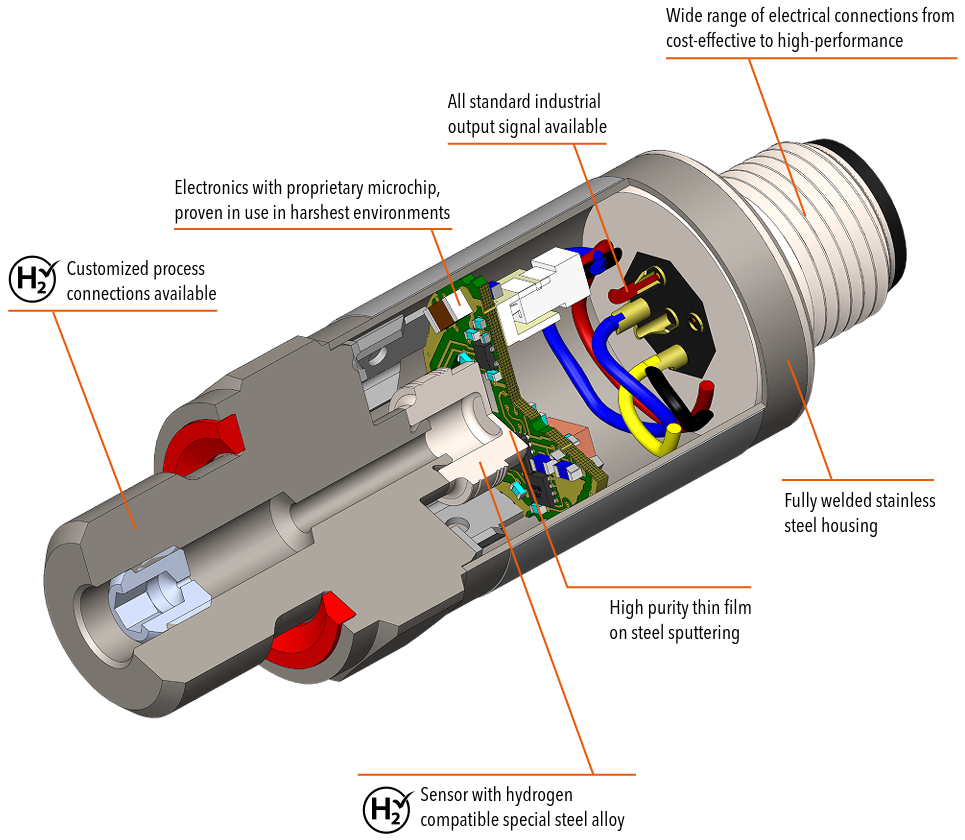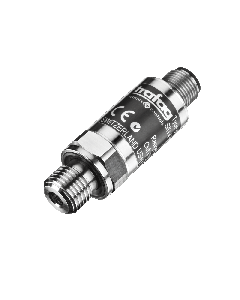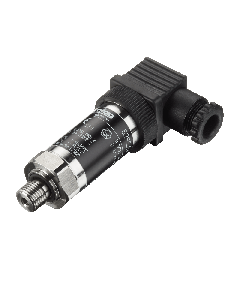Hydrogen – miracle weapon against climate change
Hydrogen has the potential to replace fossil fuels such as gas, coal and oil. It is therefore often seen as a beacon of hope for a sustainable future. In fact, hydrogen can power vehicles, store green electricity, make industry climate-friendly and make a decisive contribution to reducing greenhouse gas emissions. However, pressure measurement technologies play a key role here.
(Extract from the Sustainability Brochure)
What does it actually take for hydrogen to realise its full potential as an energy carrier? Quite simply: sophisticated technical solutions! Small, precise pressure sensors that can measure the pressure in hydrogen systems stably and accurately are particularly important. This is the only way to operate the systems safely and efficiently.
The good news is that innovative technical developments will make it possible to establish hydrogen as an environmentally friendly energy source on a large scale in the long term.
However, there is no way around the technical challenges of the hydrogen economy.
The hydrogen industry depends on reliable pressure measurement
Hydrogen mobility, i.e. the operation of cars, buses and lorries through to rail vehicles and aircraft, requires a very high pressure in the tanks. This is the only way to store sufficient energy to cover similarly long distances without refuelling as with fossil fuels. Vehicle tanks are therefore usually refuelled at a pressure of 350 or even 700 bar. The requirements for valve technology, tanks and compressors in the petrol stations and, of course, for the pressure measurement integrated everywhere are correspondingly high.
While hydrogen has been used in the chemical and process industries for many years at low pressure and monitored in terms of pressure, special challenges arise when hydrogen is used as an energy source and in mobility:
Pressure measuring ranges of up to 1,000 bar, often limited space and at the same time high cost pressure for large series require innovative sensor concepts.
Challenges in the pressure measurement of hydrogen
The hydrogen molecule is a technical tricky nut to crack. As the smallest molecule of all, it can penetrate the structure of many commercially available steels and other materials by diffusion. The consequences: It either becomes permanently embedded in the structure or penetrates it (permeation). A combination of both effects is also frequently encountered. Hydrogen embrittlement is also very well known. This occurs when penetrated hydrogen changes the structure of the steel. In the case of hydrogen permeation, sorption (absorption) on the membrane surface is followed by diffusion through the membrane material and desorption on the reverse side. This process is not a problem in most applications due to the sufficiently large wall thicknesses (for example in pressurised tanks). However, in pressure sensors with their inherently thin walls, the permeation of hydrogen through the measuring diaphragm can lead to a reaction with the sensor elements. This can permanently damage the sensor, resulting in incorrect measured values.
The innovative solution is in Trafag products
Pressure sensors are usually made of steel alloys, which are very susceptible to reactions with hydrogen. For this reason, attempts are sometimes made to prevent the penetration of hydrogen with a gold coating. However, this gold coating is sometimes inadequate, namely when it is too thin or is damaged in places during operation. Trafag has developed an innovative solution here: a special steel alloy for pressure sensors that come into contact with hydrogen. This alloy of nitrogen-hardened, austenitic steel is not only compatible with hydrogen, but also has the material properties required for robust, accurate and long-term stable pressure sensors.
Trafag has combined the pressure measuring cell made of this special steel alloy with the design of mobile hydraulic pressure transmitters and the proven components tested under the toughest conditions to create a new product line of pressure transmitters: the NHT 8250. hydrogen pressure transmitters. At the same time, the measuring cell was integrated into a pressure transmitter established in shipbuilding, which is also approved for use in potentially explosive atmospheres (Ex zones).
These two product lines cover the requirements of a wide range of hydrogen applications: in energy generation in electrolysers, in valves for mobile and stationary tanks, in compressors and petrol stations, in fuel cells and even in combustion engines that can run on up to 100% hydrogen. Reliable pressure monitoring as the basis for the safe use of hydrogen as a sustainable energy source is therefore guaranteed.
Trafag Sustainability Brochure
Contact us
Do you have questions about hydrogen and/or hydrogen pressure transmitters? Our specialists will be happy to provide you with expert advice.





